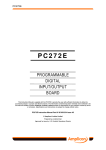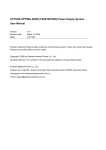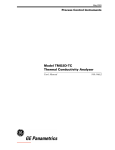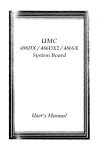Download Amplicon Liveline PC27E Instruction manual
Transcript
PC24E and PC25E HIGH SPEED FOUR CHANNEL DIGITAL TO ANALOG CONVERTER BOARDS This Instruction Manual is supplied with the PC24E or PC25E to provide the user with sufficient information to utilise the product in a proper and efficient manner. The information contained has been reviewed and is believed to be accurate and reliable, however Amplicon Liveline Limited accepts no responsibility for any problems caused by errors or omissions. Specifications and instructions are subject to change without notice. PC24E and PC25E Instruction Manual Part Nº 859 561 84 Issue A3 © Amplicon Liveline Limited Prepared by Technical Publications Approved for issue by A.S. Gorbold, Operations Director PC24E/25E Page 1 DECLARATION OF CONFORMITY AMPLICON LIVELINE LIMITED CENTENARY INDUSTRIAL ESTATE HOLLINGDEAN ROAD BRIGHTON BN2 4AW UK We declare that the product(s) described in this Instruction Manual are manufactured by Amplicon Liveline Limited and perform in conformity with the following standards or standardisation documents: Electro Magnetic Compatibility (EMC): EMC Directive LVD Directive CE Directive 89/336/EEC 73/23/EEC 93/68/EEC Jim Hicks, I. Eng, FIEIE Managing Director Amplicon Liveline Limited PC24E/25E Page 2 PC24E AND PC25E HIGH SPEED FOUR CHANNEL D to A CONVERTER BOARD CONTENTS PARAGRAPH SUBJECT PAGE 1. 1.1 1.2 1.3 GENERAL INFORMATION General Description What the Package Contains Features 2. 2.1 2.2 2.3 2.4 2.5 2.5.1 2.5.2 2.5.3 2.5.4 2.5.5 2.5.6 2.5.7 2.5.8 2.5.9 USING THE PC24E/25E General Information Requirements to Run the Software Backing up the Software Diskette Installing the Software onto a Fixed Hard Disk User Settings Board Base Address Interrupt Request Selection Wait State Generator Setting (Option) DAC Loading Mode Voltage Output Ranges (PC24E Only) Installing the PC24E or PC25E in the Computer Testing the PC24E/25E Calibrating the PC24E Calibration Check of the PC25E 6 6 6 6 7 7 7 8 10 11 11 12 13 13 14 3. 3.1 3.2 3.3 ELECTRICAL CONNECTIONS User Connections EMC Considerations Main I/O Bus Backplane Connections 15 15 15 16 4. 4.1 4.2 4.2.1 4.2.2 4.3 4.4 PROGRAMMING THE PC24E/25E Windows DLLs and Visual Basic Example Programs Turbo Pascal Demonstration DOS Program Loading the Program Running the Demonstrations Input/Output Address Space used by the PC24E/PC25E Programming the AD7548 Digital to Analog Converter 17 17 17 17 17 18 19 5. 5.1 5.2 TECHNICAL SPECIFICATIONS Electrical Specification Physical Specification 22 22 22 6. NOTES 27 5 5 5 6 PC24E/25E Page 3 LIST OF FIGURES FIGURE TITLE PAGE FIGURE 1 FIGURE 2 FIGURE 3 FIGURE 4 FIGURE 5 FIGURE 6 FIGURE 7 FIGURE 8 FIGURE 9 FIGURE 10 FIGURE 11 FIGURE 12 FIGURE 13 FIGURE 14 FIGURE 15 FIGURE 16 SW1 DIL SWITCH SELECTION OF BASE ADDRESS IRQ LEVEL SELECTION CLOCK JUMPER SELECTION GENERAL PURPOSE CLOCK JUMPER SELECTION J15 WAIT STATE SETTINGS DAC LOADING MODES PC24E OUTPUT VOLTAGE RANGES CONNECTOR PL1 PIN DESIGNATIONS MAIN PC BUS BACKPLANE CONNECTOR PIN ASSIGNMENTS INPUT/OUTPUT ADDRESS SPACE BIPOLAR TRANSFER FUNCTION UNIPOLAR TRANSFER FUNCTION PC24E PRINTED CIRCUIT BOARD LAYOUT PC24E CIRCUIT DIAGRAM PC25E PRINTED CIRCUIT BOARD LAYOUT PC25E CIRCUIT DIAGRAM LIST OF APPENDICES APPENDIX SUBJECT 82C53 Data Sheets on 82C53 Counter/Timer PC24E/25E Page 4 8 8 9 10 11 11 12 15 16 18 19 20 23 24 25 26 PC24E AND PC25E HIGH SPEED FOUR CHANNEL D to A CONVERTERS 1. 1.1 GENERAL INFORMATION General Description The PC24E and PC25E are four channel, 12-bit digital to analog converter cards for installation in an IBM PC/XT/AT, PS2/30 or compatible computer. The PC24E is a four channel analog voltage output card with individual jumper selectable output ranges of 0 to +2.5v, ± 2.5v or 0 to +10v, ±10v. The PC25E is a four channel analog current output card, sourcing 4 - 20 mA between current output and ground. The output stages of the PC25E can be powered from the internal +12v supply rail or from a 24 volt external supply when the driven impedance is high. The flexible addressing system provided on the board allows the base address to be set within the range 000 to FF0 hex. A set of jumpers allows selection of an interrupt level within the range IRQ2 to IRQ7. A 1MHz on-board oscillator provides an accurate source for the counter/timers, independent of the system clock frequency. The oscillator can be disabled if the small amount of noise injected into the analog outputs is not acceptable. Windows DLLs with Visual Basic examples, and demonstration software written in Turbo Pascal is included. 1.2 What the Package Contains The package as delivered from Amplicon Liveline Ltd. contains:1. The PC24E or PC25E plug-in card protected by an anti-static plastic envelope. SOME OF THE COMPONENTS ON THE BOARD ARE SUSCEPTIBLE TO DAMAGE BY ELECTROSTATIC DISCHARGE, AND PROPER HANDLING PRECAUTIONS SHOULD BE OBSERVED. AS A MINIMUM, AN EARTHED WRIST STRAP MUST BE WORN WHEN HANDLING THE PC24E/25E. FULL STATIC HANDLING PROCEDURES ARE DEFINED IN BRITISH STANDARDS PUBLICATION BS5753. WHEN REMOVED FROM THE BAG, INSPECT THE BOARD FOR ANY OBVIOUS SIGNS OF DAMAGE AND NOTIFY AMPLICON IF SUCH DAMAGE IS APPARENT. DO NOT PLUG A DAMAGED BOARD INTO THE HOST COMPUTER. KEEP THE PROTECTIVE BAG FOR POSSIBLE FUTURE USE IN TRANSPORTING THE BOARD. 2. The Windows DLLs and demonstration software on 3.5 inch diskettes (part nº 85956184). 3. This PC24E/25E Instruction Manual (Amplicon part number 859 561 84). Any additional accessories (terminal assembly and cable etc.) may be packed separately. PC24E/25E Page 5 1.3 Features • Four 12-bit digital to analog converters. • Unipolar or Bipolar operation in four user selectable ranges (PC24E only). • 4-20mA output (PC25E only). • On-board 1MHz frequency reference that can be disabled for ultra quiet operation. • Two triggering modes. • Flexible addressing. • On-board programmable wait state generator for compatibility with faster machines. 2. 2.1 USING THE PC24E/25E General Information The PC24E/25E is supplied with the Amplicon Introductory DLL package - a suite of Windows DLLs with Microsoft Visual Basic example programs which support Amplicon’s range of lowcost data acquisition boards, namely PC14AT, PC24E, PC25E, PC27E, PC26AT, PC30AT, and PC36AT. The PC24E/PC25E is also supplied complete with demonstration software written in Borland Turbo Pascal. The source code for the demonstration program is supplied and is compatible with compiler versions 4 and above. A number of user settings are available on the board, and these should be configured to the user's requirements before installing the PC24E/25E in the host computer. 2.2 Requirements to Run the Software The following software and hardware are required in order to enable the program to be run: - Windows 3.1 or later. - An IBM PC or compatible. - PC24E or PC25E (fitted). - 3 1/2 inch disk drive. - A monitor. 2.3 Backing up the Software Diskette It is important that you make a backup copy of the software diskette and store the original in a cool dry safe place. The diskette can be copied onto another, blank diskette by using the MSDOS command: DISKCOPY A: A: on a single drive machine, or: DISKCOPY A: B: on a twin drive machine. Always use the copy for your work. Running the software is described in section 4. PC24E/25E Page 6 2.4 Installing the Software onto a Fixed Hard Disk To install the software onto your hard disk, insert the diskette into drive A and select File|Run... from the Windows Program Manager, or if you are using Windows 95 select Run... from the Start menu. In the dialogue box that follows, type A:\SETUP <RETURN> The PC24E/25E software setup program will now run. Follow the instructions given on the screen to complete the installation. See Section 4 ‘Programming the PC24E/25E’ for details on running the software. 2.5 User Settings The PC24E or PC25E can be operated at the factory default settings of the switches and jumpers, but to configure the board to specific requirements without conflict with other possible functions of the host computer, all operations described in this section should be checked. 2.5.1 Board Base Address The PC24E/PC25E can have its base address situated within the range 000 to FF0 hex. This feature provides the flexibility to avoid any contention in I/O mapping that may arise and allows the use of multiple cards fitted in the PC expansion slots. 2.5.1.1 Factory Setting The board’s base address is set at the factory to be 300 hex. 2.5.1.2 Customer Configured Base Address The board’s base address can be selected as any sixteenth address within the range 000 to FF0 hex by means of the appropriate settings of switch SW1. This switch bank comprises a row of eight single pole switches with each 'ON' (up) position selecting a logic 0, and each 'OFF' (down) position selecting a logic 1. The most significant hex digit is coded by the four most left switches and the middle hex digit is coded by the four most right switches of SW1. The least significant digit is fixed at zero. Figure 1 below shows the factory setting of the base address at 300 hex Most significant digit Middle digit Least significant 0011 0000 Fixed = 3 hex = 0 hex = 0 hex PC24E/25E Page 7 Figure 1 SW1 DIL SWITCH SELECTION OF BASE ADDRESS 2.5.2 Interrupt Request Selection To accurately time DAC output waveforms, a programmable clock interrupts the host computer on a selected IRQ level at the required intervals. 2.5.2.1 Jumper Setting of IRQ Level An interrupt level must be chosen that is not otherwise used in the system. Note that unless the interrupts are specifically supported by the software in use, the interrupt has no effect on the PC bus. The IRQ level to be used is selected on J13. Only one level may be selected by positioning a single jumper at the required IRQ level 2 to 7 as illustrated in figure 2. IRQ 2 3 4 5 6 7 J13 Figure 2 IRQ LEVEL SELECTION 2.5.2.2 Jumper Setting of Programmable Timer 1. Generating an Interrupt The interrupts are generated by the counter/timer QA14 which is an 82C53 and fully described in the data sheets contained in the appendix. A crystal oscillator provides an accurate 1MHz source which is hard wired to clock 0 input. Jumper J10 selects the output from any one of the three possible timer outputs. These are labeled '0' for counter 0, '1' for counter 1 and '2' for counter 2. To use counter 1, its input may be cascaded to the output of counter 0. This is done by plugging jumper J12 in the 'UP' position. With J12 in the 'DOWN' position, counter 0 output is directed to the output connector, PL1 pin 16. Similarly with J11 in the 'UP' position, counter 2 input is cascaded to PC24E/25E Page 8 the output of counter 1, and in the 'DOWN' position, counter 1 output is available at the output connector, PL1 pin 4. For counter 2 to generate a hardware interrupt, it must be cascaded with counter 1 and counter 0. The various configurations of jumpers J10, 11 and 12 for internal interrupt generation are shown in figure 3. Timer Range 2 µSecs to 65 mSecs Counters In Use Jumper Configuration Cntr 0 J10 IRQ TIMER 2 1 8 µSecs to >24 Hrs 0 DN J12 J10 IRQ Ctrs 0 and 1 TIMER 2 IRQ from Cntr 1 Ctrs 0, 1 and 2 Cntr 0 UP IRQ from Cntr 0 J11 4 µSecs to 70 Mins 1 0 Cntr 1 UP DN J11 J12 J10 IRQ TIMER 2 1 0 None UP IRQ from Cntr 2 External Outputs DN J11 J12 Figure 3 CLOCK JUMPER SELECTION 2. General Purpose Use If no IRQ generation is required, the counter/timers can be used for any counting/timing function, and the Clock, Gate and Output signals of each counter/timer are available on the output connector PL1, with the exception of Counter 0 Clock, which is hard wired to the crystal oscillator’s 1MHz source, and Counter 0 Gate, which is set at +5V (permanently enabled). Figure 4 shows the general jumper configuration for the counter/timers. If no IRQ generation is required, and the counter/timers are not in use, it is recommended that the on-board oscillator is disabled by inserting J14. PC24E/25E Page 9 OUT2 J20 PL1-3 GAT2 J16 PL1-1 CLK2 J18 PL1-14 UP OUT1 PL1-4 J11 DN GAT1 J17 PL1-2 CLK1 J19 PL1-15 UP OUT0 J12 PL1-16 DN GAT0 +5V CLK0 1MHz J10 IRQ 2 1 0 Figure 4 GENERAL PURPOSE CLOCK JUMPER SELECTION 2.5.3 Wait State Generator Setting (Option) The PC24E/PC25E has an option to incorporate an on-board wait state generator (QA19) to enable it to operate reliably in a wide range of PC/XT/AT and ISA machines. The need for this is because some machines, that are otherwise IBM compatible, operate the I/O expansion bus at clock frequencies higher than the 8 MHz specified in the ISA standard. This option is not fitted as standard. Many interface ICs currently available cannot operate at these higher frequencies and it becomes necessary to slow down the bus interface signals, locally, on the PC24E/PC25E board. The degree of retardation can be adjusted to give optimum performance in any machine. Being local to the PC24E/PC25E board, this slowing down in no way impairs the performance of the host computer. The expansion bus frequency is not necessarily the same as that of the main processor clock. A computer which is specified as a 12 or 16 MHz machine could well have an expansion bus frequency of 8 MHz. Unless explicitly stated in the machine specification there is no easy way to establish the speed of the expansion bus. If you can establish the expansion bus clock frequency for your machine, use figure 5 to set the appropriate number of wait states. If the expansion bus clock frequency is unknown, it is suggested that you leave the number of wait states at the default setting of zero (No jumper). If the operation is erratic, increase the wait states to 1, 2 or 3 by plugging in a single jumper, until proper operation is achieved. If the number of wait states is set too high, the response of the PC24E/25E will not be optimum. Some computers will not tolerate wait states on expansion boards, in which case the jumper J15 must always be left out. PC24E/25E Page 10 Nº OF WAIT STATES EXPANSION BUS SPEED J15 JUMPER SETTING 0 1 2 3 Up to 8 MHz 8 to 10 MHz 10 to 12 MHz 12 MHz and above No jumper 3 4 5 Figure 5 J15 Wait State Settings 2.5.4 DAC Loading Mode Each Digital to Analog Converter (DAC) has twelve bits resolution and the data word is right justified and loaded sequentially in two bytes, the least significant byte (LSB) of eight bits and the most significant byte (MSB) of four active bits. Jumper facilities are provided so that the data word can be loaded either MSB last or LSB last. The correct setting of the jumpers relative to the user's program will ensure that the DAC analog output is updated when both bytes have been loaded. Jumpers J6, J7, J8 and J9 select the loading mode for each of the DACs. associated with DAC4, J7 with DAC3, etc. Jumper Number DAC Number J6 4 J7 3 J8 2 J9 1 Note J6 is Loading Sequence LSB Last LSB MSB Last MSB LSB MSB Figure 6 DAC LOADING MODES The loading mode of each channel can be separately selected as indicated in the table shown in figure 6. Mixed loading modes can be supported on a single board. Factory default setting is all DACs loaded LSB first with the analog output updated on loading of the MSB. 2.5.5 Voltage Output Ranges (PC24E Only) The voltage output range of the four DACs on the PC24E can be set by jumpers according to the table in figure 7. The four DAC channels can be independently selected for unipolar or bipolar operation, but the maximum output voltage set by jumper J3 applies to all four channels simultaneously. PC24E/25E Page 11 The PC24E is supplied with all four channels set up and calibrated for +10V unipolar operation. If the range is changed, the output voltages should be checked and recalibrated if necessary using the procedure described in paragraph 2.5.8. Jumper J3 is available on the PC25E, but would normally remain set at the default position of 10V. However, if special scaling of the PC25E for low current outputs is required, then jumper J3 may be positioned at 2.5V. J3 Range Jumper DAC Channel Polarity Jumper UP J3 10V 2.5V 10V 2.5V UP BP BP 1 J1 0 to +10V +10 to - 10V 2 J2 0 to +10V +10 to - 10V 3 J4 0 to +10V +10 to - 10V 4 J5 0 to +10V +10 to - 10V UP J3 BiPolar Output Voltage Range UniPolar Output Voltage Range UP BP BP 1 J1 0 to +2.5V +2.5 to -2.5V 2 J2 0 to +2.5V +2.5 to -2.5V 3 J4 0 to +2.5V +2.5 to -2.5V 4 J5 0 to +2.5V +2.5 to -2.5V Figure 7 PC24E OUTPUT VOLTAGE RANGES 2.5.6 Installing the PC24E or PC25E in the Computer When the board has been correctly set up for the application as described above, it may be installed in the host PC. If this is the first time you have installed a peripheral card in your computer, you should refer to the hardware manual supplied with your machine for instructions on how to remove the cover and install devices into the input/output slot. The PC24E or PC25E may be installed in any available slot in the machine provided that there is no restriction specified for the slot by the manufacturer of the machine. ENSURE THAT THE POWER TO THE COMPUTER IS SWITCHED OFF BEFORE INSTALLING OR REMOVING ANY EXPANSION BOARD. ALWAYS WEAR AN EARTHED WRIST STRAP AND OBSERVE PROPER PRECAUTIONS IN HANDLING THE PC24E/25E AND ANY OTHER BOARDS BEING INSTALLED OR REMOVED. REPAIR OF DAMAGE CAUSED BY MIS-HANDLING IS NOT COVERED UNDER THE AMPLICON WARRANTY. PC24E/25E Page 12 2.5.7 Testing the PC24E/25E When installation is complete, the PC24E/25E can be tested by loading and running the programs on the supplied demonstration disk and measuring the fixed outputs using a digital multimeter or viewing the sine wave outputs on an oscilloscope. See section 4. 2.5.8 Calibrating the PC24E When the output voltage range of any channel is changed by jumper selection, the calibration should be checked using the following procedure. 1. UniPolar Calibration 1.1 Ensure that the settings of jumpers J1, J2, J4 and J5 are correct for unipolar (UP) operation on the required channels and the desired voltage range, 2.5 or 10V, is set on J3. This voltage range applies to all four channels whether unipolar or bipolar. 1.2 Connect an accurate digital voltmeter to measure the voltage at the output of the first channel being calibrated. 1.3 Load and run the demonstration program PC24E/25E as described in section 4. 1.4 Select item 3 from the menu. ' Write a value to all four DACs'. 1.5 Enter the data value 4095 which gives a positive full scale output voltage of +2.500 or +10.000 as selected by J3. Press any key twice to load the DACs. 1.6 Adjust the appropriate trimmer potentiometer to give exactly +2.500V or +10.000V according to the setting of J3. The potentiometers located at the top of the board are adjusted according to the following table. Channel (DAC) Nº 1 2 3 4 Output Pin Nº 11 9 7 5 Trimmer Pot. RV1 RV2 RV7 RV8 1.7 If any channel will not adjust to the required value over the full span of the potentiometer, then raise or lower the reference voltage by adjusting RV13 until all channels can be correctly set up. Repeat the calibration procedure. 1.8 Enter 0 and confirm to exit the program 2. BiPolar Calibration 2.1 Ensure that the settings of jumpers J1, J2, J4 and J5 are correct for bipolar (BP) operation on the required channels and the desired voltage range, 2.5 or 10V, is set on J3. This voltage range applies to all four channels whether unipolar or bipolar. 2.2 Connect an accurate digital voltmeter to measure the voltage at the output of the first channel being calibrated. 2.3 Load and run the demonstration program PC24E/25E as described in section 4. 2.4 Select item 3 from the menu. ' Write a value to all four DACs'. PC24E/25E Page 13 2.5 Enter the data value 4095 which gives a negative full scale output voltage of –2.500 or –10.000 as selected by J3. Press any key twice to load the DACs. 2.6 Adjust the appropriate trimmer potentiometer to give exactly –2.500V or –10.000V according to the setting of J3. The potentiometers located at the top of the board are adjusted according to the table below. 2.7 Select item 3 from the menu. ' Write a value to all four DACs'. 2.8 Enter the data value 0 which gives a positive full scale output voltage of +2.500 or +10.000 as selected by J3. Press any key twice to load the DACs. 2.9 Adjust the appropriate trimmer potentiometer to give exactly +2.500V or +10.000V according to the setting of J3. The potentiometers located at the top of the board are adjusted according to the following table. Channel (DAC) Nº 1 2 3 4 Output Pin Nº 11 9 7 5 Trimmer Negative RV1 RV2 RV7 RV8 Potentiometer Positive RV5 RV6 RV9 RV10 2.10 If any channel will not adjust to the required value over the full span of the potentiometer, then raise or lower the reference voltage by adjusting RV13 until all channels can be correctly set up. Repeat the calibration procedure. 2.5.9 2.11 Repeat 2.4 through 2.9 until both ends of the scale are accurately set. 2.12 Enter 0 and confirm to exit the program. Calibration Check of the PC25E The PC25E has a single range of 4 to 20mA which is properly calibrated at the factory. This calibration can be checked if necessary using similar techniques to the above and measuring the output current with a digital multimeter on a suitable d.c. current range. Setting a value of 4095 should produce 20mA and setting a value of 0 should produce 4mA. PC24E/25E Page 14 3. 3.1 ELECTRICAL CONNECTIONS User Connections All user input/output connections are via a 25 way D type connector PL1. The pinouts for this connector are shown in figure 8. PC24E No Conn Gnd Chan 1 O/P No Conn Chan 2 O/P No Conn Chan 3 O/P No Conn Chan 4 O/P Out 1 Out 2 Gate 1 Gate 2 13 12 11 10 9 8 7 6 5 4 3 2 1 PC25E 25 24 23 22 21 20 19 18 17 16 15 14 No Conn Gnd Chan 1 AGnd No Conn Chan 2 AGnd No Conn Chan 3 AGnd No Conn Chan 4 AGnd Out 0 Clk 1 Clk 2 Ext Voltage Gnd Chan 1 O/P No Conn Chan 2 O/P No Conn Chan 3 O/P No Conn Chan 4 O/P Out 1 Out 2 Gate 1 Gate 2 13 12 11 10 9 8 7 6 5 4 3 2 1 25 24 23 22 21 20 19 18 17 16 15 14 Ext Voltage Gnd Chan 1 AGnd No Conn Chan 2 AGnd No Conn Chan 3 AGnd No Conn Chan 4 AGnd Out 0 Clk 1 Clk 2 Figure 8 CONNECTOR PL1 PIN DESIGNATIONS Notes to figure 8: 1. 'No Conn' means no connection to this pin 2. Chan 1 (channel 1) is the output of DAC 1, chan 2 the output of DAC 2 and so on. 3. Analog output channels should be referred to their own ground pins (AGnd) 4. Counter connections are available via jumpers J11, J12, and J16 to J20. 5. Ext (external) Voltage must be in the range +12 to +30 (max) volts DC. 6. Counter connections and external voltage inputs should be referred to Gnd (digital ground) 3.2 EMC Considerations In order to maintain compliance with the EMC directive, 89/336/EEC, it is mandatory that the final system integrator uses good quality screened cables for external connections. It is up to the final system integrator to ensure that compliance with the Directive is maintained. Amplicon Liveline offers a series of good quality screened cables for this purpose. Please contact our sales staff. PC24E/25E Page 15 3.3 Main I/O Bus Backplane Connections Connection to the computer is made through the 62 pin I/O bus connector (Pins B1 and A1 are at the bracket end of the board). Pin connections are shown in figure 9. For further information please consult the technical reference manual for the host computer. S O L D E R S I D E Ground +Reset +5Volts +IRQ2/9* -5Volts +DRQ2 -12Volts -0WS +12Volts Ground -SMEMW -SMEMR -IOW -IOR -DACK3 +DRQ3 -DACK1 +DRQ1 -DACK0 CLK +IRQ7 +IRQ6 +IRQ5 +IRQ4 +IRQ3 -DACK2 +T/C +BALE +5Volts OSC Ground < < < > < > < <> < < < < <> <> <> <> <> <> <> <> <> <> <> <> <> <> < < < < < B1 B2 B3 B4 B5 B6 B7 B8 B9 B10 B11 B12 B13 B14 B15 B16 B17 B18 B19 B20 B21 B22 B23 B24 B25 B26 B27 B28 B29 B30 B31 A1 A2 A3 A4 A5 A6 A7 A8 A9 A10 A11 A12 A13 A14 A15 A16 A17 A18 A19 A20 A21 A22 A23 A24 A25 A26 A27 A28 A29 A30 A31 < <> <> < <> <> <> <> <> < <> <> <> <> <> <> <> <> <> <> <> <> <> <> <> <> <> <> <> <> <> -I/OCHCK SD7 SD6 SD5 SD4 SD3 SD2 SD1 SD0 I/OCHRDY AEN SA19 SA18 SA17 SA16 SA15 SA14 SA13 SA12 SA11 SA10 SA9 SA8 SA7 SA6 SA5 SA4 SA3 SA2 SA1 SA0 C O M P O N E N T S I D E * Note: Pin B4 is IRQ2 for an XT. Pin B4 is IRQ9 for an AT which is re-directed as IRQ2 Figure 9 MAIN PC BUS BACKPLANE CONNECTOR PIN ASSIGNMENTS PC24E/25E Page 16 4. PROGRAMMING THE PC24E/25E The PC24E/PC25E is supplied with a 31/2 inch diskette containing Windows DLLs with Microsoft Visual Basic example programs, and a Borland Turbo Pascal DOS demonstration program. See Section 2.4 to find out how to install the software onto your hard disk. 4.1 Windows DLLs and Visual Basic Example Programs Having installed the software, you will find a number of Windows Dynamic Link Libraries (DLLs) each of which supports one basic Input/Output function available with the Amplicon low-cost Data Acquisition boards. Each DLL comes with a Visual Basic example program (source code is also provided), and any number of these programs can be run concurrently to build up the system represented by one or more of the boards being used. The default installation for the PC24E/25E creates four new icons in the ‘Amplicon Introductory DLLs’ folder/Program Manager group: DA24DEMO TC53DEMO README AMPLICON LIVELINE LTD - Visual Basic analog output demo program - Visual Basic timer/counter demo program - User Guide for the Amplicon Introductory DLLs - What Amplicon offers you To open any of these objects, simply double-click the mouse on the relevant icon. For more information on the functions provided by the DLLs, and how to use them in your own Visual Basic Windows programs, please read the User Guide by double-clicking on the README icon. 4.2 Turbo Pascal Demonstration DOS Program Two Turbo Pascal files are also installed into the Introductory DLL directory: PC2425.PAS PC2425.EXE 4.2.1 Loading the Program Both source (PC2425.PAS) and executable (PC2425.EXE) versions of the demonstration programs are provided. To run the Executable version of the demonstration program: 1. Boot up. 2. Log on to the disk drive or directory containing the demonstration software and type: PC2425 <RETURN>. 4.2.2 Running the Demonstrations After booting up and selecting PC2425.EXE, the first menu screen is displayed. The choices are: 1. Change PC24E/PC25E card base address. 2. Write a value to one DAC only. PC24E/25E Page 17 3. Write a value to all DACs. 4. Output a Sine wave to one DAC. 5. Output a Sine wave to all DACs. 6. Exit. Option 1 need only be chosen if a base address other than the factory set 300 hex has been set up on the board. Enter a number 2 to 4 to choose the required output(s) and follow the on-screen instructions. Note: All values are input as decimal numbers, which can take any value from 0 to 4095. 4.3 Input/Output Address Space used by the PC24E/PC25E When writing application software for the PC24E/25E, the programmer will need to know the location of all DAC and Timer registers in the I/O space. These locations are given in figure 10 below, showing each register as an offset from the base address set up on the board. For example, if the base address is set at 300 hex, then the 82C53 control register is at 30B hex. NOTE Selection of the order in which the MSB and LSB are loaded into the DACs ( jumpers J6 - 9 ) has no effect on the register addresses. Address Function BA + 00 BA + 01 DAC1 (lo byte) DAC1 (hi byte) BA + 02 BA + 03 DAC2 (lo byte) DAC2 (hi byte) BA + 04 BA + 05 DAC3 (lo byte) DAC3 (hi byte) BA + 06 BA + 07 DAC4 (lo byte) DAC4 (hi byte) BA + 08 BA + 09 BA + 0A 82C53 Counter/Timer 0 82C53 Counter/Timer 1 82C53 Counter/Timer 2 BA + 0B 82C53 Control Register Figure 10 INPUT/OUTPUT ADDRESS SPACE Notes to figure 10: 1. 2. 3. BA = Base Address as set on SW1. Register address is Base Address plus offset. Offset to be added to the BA is stated as a Hex value. PC24E/25E Page 18 4.4 Programming the AD7548 Digital to Analog Converter The PC24E/25E has been designed for straightforward user programming of the four DAC chips. Being 12 bit DACs they have to be loaded by sending the output data as two bytes to the appropriate DAC register addresses as shown in figure 10 above. Note that the data must be right justified and the order of sending the two bytes must be as selected by jumpers J6 to J9. The source code supplied with the demonstration software may be taken as examples of programming the DACs. When the PC24E is operated in the Bipolar mode, writing 0 to the DACs will give a full POSITIVE output, writing 2047 (7FF hex) will give 0 volts and writing 4095 (FFF hex) will give full NEGATIVE output. The bipolar transfer function is shown in figure 11 below. 1LSB = 2 x FS/4095 + FS (+10V or +2.5V) Bipolar Transfer Function O U T P U T 0 Volts 7FEh 001h 000h - FS (-10V or -2.5V) 800h FFEh 7FFh V O L T A G E FFFh DIGITAL INPUT CODES Figure 11 BIPOLAR TRANSFER FUNCTION When operating the PC24E in the unipolar mode, writing 0 to the DACs will give 0V out and writing 4095 (FFF hex) will give full scale +2.5 or +10 V. The PC25E is always unipolar and writing 0 to the DACs will give 4mA out and writing 4095 (FFF hex) will produce 20mA. The unipolar transfer function is shown in figure 12 below. PC24E/25E Page 19 1LSB=FS/4095 + FS (+10V or +2.5V or 20mA) Unipolar Transfer Function O U T P U T Half Scale V or I Zero (0V or 4mA) 000h 7FFh FFFh DIGITAL INPUT CODES Figure 12 UNIPOLAR TRANSFER FUNCTION 4.4 Programming the 82C53 Counter/Timer Full details of the 82C53 Counter/Timer and its various programming modes are given in the appendix. The three counter/timers of the 82C53 can be independently programmed to operate in any one of six modes, but circuit considerations mean that only mode 2, Rate Generator or mode 3, Square Wave Generator are useful for generating timed IRQ pulses. The function of a particular timer/counter is established by writing a control word to the control register which is located at BA + 0Bhex. This 8 bit word consists of four fields as follows: D7 D6 D5 Select Counter D0 D4 Read/Load D3 D2 D1 Select Mode = 0: = 1: Binary counter selected. BCD counter selected. = x 10: = x 11: Mode 2 Rate Generator selected. Mode 3 Square Wave Generator selected. D5,D4 = 00: = 01: = 10: = 11: Latch Counter. Read/Load LSB Read/Load MSB Read/Load LSB followed by MSB D7,D6 = 00: = 01: = 10: = 11: Counter 0 selected. Counter 1 selected. Counter 2 selected. Prohibited combination. D3,D2,D1 D0 BCD or Binary Example 1 To select Counter 1 to Mode 3, loading/reading low order byte followed by high order byte binary, the controls word is: PC24E/25E Page 20 0 1 1 1 0 1 1 0 = 76 hex. This value has to be loaded to the control register whose address is Base Address + 0B. Assuming that the board address is 0300, the BASIC statement OUT &H030B, &H76 will load the control register with 76 hex. The value of the count has now to be loaded to the counter. The address of Counter 1 is base address + 09 which, in our example would be 0309. To load the value 50 decimal to this counter the following BASIC statement is used OUT &H0309, &H32 : OUT &H0309, &H00 It should be noted that both the low order and high order bytes have to be loaded even though the high order byte, as in the above example, is zero. Example 2 To read the current count on Counter 1 without affecting the counting operation the counter has to be latched. To do this the control word 0 1 0 0 0 1 1 0 (46 hex) is loaded to the control register by OUT &H030B, &H46. The two bytes then have to be read from the latch using the command IN &H0309 to read the low order byte followed by IN &H0309 to read the high order byte. The two bytes MUST be read before attempting to execute another write instruction on the same counter. PC24E/25E Page 21 5. 5.1 TECHNICAL SPECIFICATIONS Electrical Specification All Analog Outputs Number of Channels Resolution Relative Accuracy Differential Nonlinearity Settling time to 0.05% FSR Reference Stability 4 12 bits ±1 LSBit ±1 LSBit 5µSec (Typ) 15 ppm/°C (Typ) Voltage Outputs (PC24E) Voltage Ranges Max. O/P Current (Source/Sink) Unipolar 2.5 or 10V Bipolar ±2.5 or 10V ±10mA Current Outputs (PC25E) Range Load Resistance (Internal Supply) External Voltage (Ref Dig Gnd) Current Required from Ext Supply Load Resistance (External 24V) 4 to 20 mA 0 to 400Ω +12 to +24V (30 Max) 80 mA 0 to 1000Ω Clock Outputs 'Low' output voltage 'High' output voltage +0.4v max at 2mA +3.7v min at -1mA. Clock Source (Can be disabled) Crystal Oscillator Frequency Frequency Tolerance Frequency Stability over temp range 1MHz ±50 ppm ±50 ppm User I/O Connector 25 way male D type. Address Range The board is addressable within the range 000-FF0 (Hex) at 16 bit boundaries. Twelve registers in I/O space. IRQ Range Interrupt Request levels IRQ2 to IRQ7. Power Powered from the host PC bus. Operating Conditions Temperature Range 5.2 +5V at 200mA +12V at 50 mA * –12V at 50mA * *these may vary dependant on loads applied +5 to +50°C Physical Specification Fits 3/4 size IBM XT or AT compatible I/O expansion bus slot. Height Width Depth Weight Card Only 107mm (+22mm locator tongue) 20mm 215mm 0.2kg PC24E/25E Page 22 Packed 180mm 90mm 420mm 0.4kg Figure 13 PC24E PRINTED CIRCUIT BOARD LAYOUT PC24E/25E Page 23 Figure 14 PC24E CIRCUIT DIAGRAM PC24E/25E Page 24 Figure 15 PC25E PRINTED CIRCUIT BOARD LAYOUT PC24E/25E Page 25 Figure 16 PC25E CIRCUIT DIAGRAM PC24E/25E Page 26 6. NOTES PC24E/25E Page 27






































